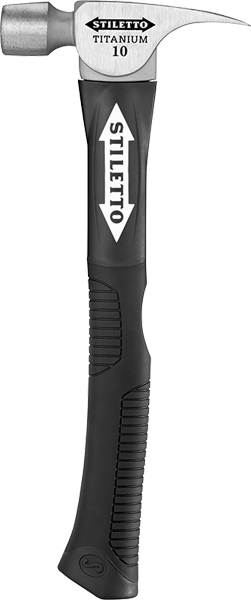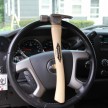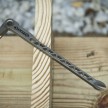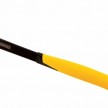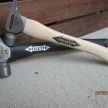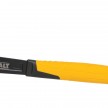Stiletto 10oz Titanium Smooth Face 14.5″ Fiberglass Handle Hammer
Stiletto 10oz Titanium Smooth Face 14.5″ Fiberglass Handle Hammer
The Stiletto 10oz titanium hammer (Model FH10C-F) is currently the smallest of Stiletto’s solid titanium hammers head hammers. It really is, as the company claims, a perfectly balanced hammer that some would call a finish hammer, but I refer to it as a general-purpose hammer. Stiletto claims that it hits like a 16oz steel hammer with 45% less weight and ten times less shock — and I concur below. First the specs:
- 10oz solid smooth face titanium head
- Newly redesigned 14.5″ curved fiberglass handle with rubber grip
- Thumb divot in handle for chocked-up delicate hammering
- Straight claw
- Magnetic nail starter
- Approximately $125 retail price
A short history of hammers
Man’s ancestor’s first tools were the stick and the rock, both often used to bash other people. Later refinements in stick and rock technology occurred back in the Pleistocene epoch when a Paleolithic gentleman named Grok combined the two into a hammer, which continued to be used to bash people. Well, it wasn’t long before every caveman and his brother just had to have one of those fashionable hammers. Pretty soon you couldn’t go anywhere without some caveguy droning on and on about his new hammer.
Later a bunch of history happened and before you knew it steel was invented, which was a big improvement in hammer technology and some other minor things. Even then hammers were occasionally used to bash other people, but by and large carpenters used them for more constructive pursuits. Then as the last century drew to a close the titanium hammer was invented, which stands as the latest advance in hammer technology. Today some cavemen still use steel hammers (cave women too), but more and more tradespeople have discovered the advantages of titanium.
After all, titanium is as strong as steel (“strong” being used in its colloquial, non-technical sense), weighs only about half as much, and transmits much less vibration. In this respect, the trades professions are behind the sports world where, for example, bicyclists have transitioned from steel to titanium decades ago for these very reasons.
Ahhh! Feels so good!
While it’s true that the way a tool performs is the most important thing, it’s also true that the way a tool (any tool: a tennis racquet, a pistol, whatever) feels in your hand is equally critical. If the tool doesn’t feel “right” when you pick it up, then the tool/person interface is wrong…for you.
Now, I am drawn to hammers. Every trip to a tool store has me hefting a couple. I have quite a few that feel good in my hand. But when this Stiletto 10-ounce hammer arrived I literally went “ahhh!” when I took it out of the box. Quite simply, I’ve never handled a hammer that felt so right, so good.
For context, I have to mention that I’ve used the same 16-ounce fiberglass-shafted hammer for just about every hammer-related task for the last 47 years, from driving 4 penny finish nails to 20 penny spikes and 16d sinkers. I’ve kinda married to that old hammer and keep coming back to it, so it’s that long-ingrained “feel” and performance that I’m comparing the Stiletto to.

The Stiletto 10oz titanium hammer-operator interface
What makes this Stiletto hammer feel so good? The length is a standard 13.5-inches, so it’s the normal length for a finish/general-purpose hammer. The fiberglass shaft has a shock-absorbing rubber handle; while hickory handles are traditional and look nice (at least at first), rubber handles provide a far better interface and better traction (especially for arthritic hands). Also, this rubber handle has grippy striations for added control. The handle is both mildly and ergonomically curved, and incorporates a swell at the end. This swell adds a tremendous amount of control on powerful swings, and when you’re tired. The handle also incorporates a thumb rest midway on the spine which is helpful for chocked-up fine work. But the balance of this hammer is the pièce de résistance. It swings easily without the same stress on the wrist as even a 16-ounce hammer. It feels like you could swing this thing all day long with a minimum of effort.
Other great features: it has straight claws which are the most useful kind (yes, a curved claw hammer provides more leverage for pulling out nails, but that comes at the cost of it being able to get into fewer tight areas to do that pulling). The head is slightly larger than the head on my much-used traditional hammer. There’s a nice magnetic nail holder/starter on the top of the head with a strong magnet that accepts 16d nails easily. The cheeks are flat and wide, so when you have to you can use them in very tight spaces for driving. And the face is smooth so that the widest range of jobs can be tackled with this hammer.
This model is not a framing hammer; it is a traditional general-purpose. I particularly wanted to look at this model for two reasons; it’s fairly new to the Stiletto line-up and because most titanium hammers on the market to date have been framers.
Aren’t hammers obsolete anyway?
Back in the day a carpenter might have easily had a hammer in his hand (it was always a “he” back then) for 80% of the workday. Even the small-framed carpenters I knew back then had Popeye-like forearms! Now of course, some sort of screw probably constitutes the majority of fasteners a carpenter uses, and if they’re using nails they’re likely to be shot out of a pneumatic or electric gun. Yet every carpenter still has a hammer hanging off their tool belt or apron, because it continues to be needed on a regular basis. As Rob points out, tradespeople of all stripes still reach for a hammer many times a day, often to make things move if not to actually drive a nail. (Rob likes the Stiletto TI-BONE framing hammers, and has a nice review of the wood-handled version of this finish/general-purpose hammer here.)

Gratuitous geeky stuff that doesn’t really matter
Of course, what really differentiates Stiletto hammers is their light-weight titanium head — 10 ounces on this finish/general-purpose model. Now, you’ve probably all read that a lighter-weight titanium hammer can be swung faster than a steel hammer, and since kinetic energy is proportional to the square of velocity, that a light titanium hammer can hit harder than a heavier steel one. Well, maybe. It all depends.
Look, there are three possible ways to measure how hard a hammer hits (or for that matter, how hard a boxer’s punch lands). There’s momentum, which is the product of mass and velocity (M=mv). There’s kinetic energy, which is the product of mass and velocity squared (E=mv^2). Then there’s force, which is the product of mass and acceleration (where here “acceleration” refers to the deceleration of the hammer (or boxer’s fist) on impact) and represented by the formula F=ma. I don’t know which of these characteristics of a swung hammer really matters most; I suspect it depends on what you’re trying to accomplish (hammer a nail, move a board, etc.) and what the nature of the resistance is. (My money’s on force for driving nails and momentum for moving stuff, but as I said, it all depends).
What I do know is that people that try a light-head (usually titanium) hammer seldom go back to steel.
The proof’s in the striking
I’ve read many tests of titanium vs steel hammers in which the number of swings to drive a nail is compared. It didn’t surprise me to see that the results were varied. Anyway, because trades people use a hammer so much less these days, the speed of nail driving is probably less important than the comfort of using the tool, with a big factor being how much or little the hammer strikes cumulatively damage your tendons and shoulders, and cramp your forearms and hands. Titanium hammers generally dampen vibration better than their steel head (and particularly steel shaft) counterparts here, and Rob considers that to be the aspect of a titanium hammer. (Although to be fair, well-designed rubber handles can mitigate a lot of shock and vibration.)
Nonetheless, a hammer is designed to drive nails. I drove 8d and 16d nails into 4×4 PT, using my trusty old 16-ounce steel head hammer and this Stiletto 10oz titanium hammer, doing my best to hit each nail the same each time. Both hammers drove the nails in with the same number of strikes. So the Stiletto 10-ounce hammer can, in my experience, in fact be said to hit like a 16-ounce hammer. Swinging the Stiletto, though, was noticeably easier.
Notice that I didn’t evaluate this hammer as a demolition tool. That’s usually a job for heavier sledge and framing hammers, and most carpenters reach for an old beater hammer or specialized demo tools for this not-delicate work.

The Devil’s own test
When I was coming up, there was one day on a job that every carpenter dreaded — that was the day that furring strips had to be installed. Furring strips are run every 16-inches crossways to the 16-on-center ceiling joists, and every cross point gets a couple of nails. Even on a modest size new house that was a lot of nails…a lot of nails that were nailed by hand, upside-down. That is, you were nailing upwards, towards the ceiling. Even the toughest carpenter’s forearms were painful after 30 minutes, screaming in pain after two hours, and in need of an ice bath after as much of the day as he could keep it up. I like hammering nails, but I hated those days.
I did have occasion to nail some 2X pieces to some ceiling joists recently, so I got to try out the Stiletto 10-ounce hammer while nailing upward, and compare it to a 16-ounce steel hammer. Again, the Stiletto hit like the 16-ounce steel hammer but was easier to swing in that awkward direction. The magnetic nail starter on this Stiletto is strong and well-designed, and it really came into its own for starting nails upside-down. What I would have given for this hammer back when I was nailing furring strips by hand.

Darla approves
Bottom line
What I found was that the Stiletto 10oz titanium hammer delivers as promised: a 16-ounce wallop, easier swinging, less fatigue, and less weight on your belt.
The only thing I might have wanted to see on this hammer was a side nail puller. True, that would have taken one of the cheeks out of running for occasional tight-space nailing, but given the usefulness of a side nail puller I might vote for that trade-off. The bottom line is that I believe this Stiletto finish/general-purpose hammer is my new go-to hammer. It took 47 years to find a replacement for my old one, but this is it.



